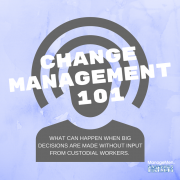How to Make Change in Your Custodial Department Easier Than Ever
When it opened in 2001, the California Environmental Protection Agency headquarters was touted as the “greenest high rise in the nation.” Waterless urinals were installed, expected to save more than 1 million gallons of water each year. Looking exclusively at the environmental benefit, engineers who called for the new technology neglected to look at how the urinals would be used and maintained. After “hundreds” of complaints about foul odors and wet floors along with “high” maintenance costs, the units were removed six years later.
A similar situation happened at City Hall in Chicago. Waterless urinals installed to “promote water conversation” ultimately created a huge stink due to a plumbing issue. Chicago’s building code requires copper pipes in commercial buildings — a material that undiluted urine will corrode over time. Ultimately, the units were removed because they “didn’t perform as expected.”
Most cleaning professionals and facility managers understand that any change is difficult, but attempting to implement anything new—a new product, system or technology—will be more difficult without first getting input and buy-in from custodial workers.
In fact, some reports indicate that not getting enough buy-in from enough people can cause as much as 70 percent of organizational change efforts to fail.
Depending on how long they’ve been with an organization, a custodian will be able to tell you what has happened in the past when someone tried something similar. They can also give you good insight into issues you might experience. In the case of waterless urinals, experienced custodians would have been able to tell you that a waterless system would take a lot more to clean than traditional urinals. Another good example is air blade hand dryers — it’s often not until installation that anyone considers how the units will be cleaned and how they’ll impact the custodial department, its daily workload and its workers who will ultimately be responsible for its daily maintenance.
Does that mean you should abandon all efforts? Not at all, but involving custodians from the start can help avert future issues.
After transitioning hundreds of organizations to the (OS1) System, we can say with confidence that we know a thing or two about implementing change in a custodial department. If you’re considering a new product (like a cordless backpack) or any new technology, here’s a few steps to keep in mind to ensure a successful rollout:
- Communicate regularly. Talk to the custodial team about what you want to do and why you want to do it. When custodial workers have a good understanding of the full picture of what you want to achieve, they will be more likely to buy into the process. It can also be beneficial to have a distributor or manufacturers’ representative speak to staff about the product so it comes a person who knows the product or equipment and can field specific questions about it.
- Start small. A pilot test gives your team members an opportunity to test the solution and see how it works—or doesn’t work. Start in a single area or building to measure performance, give users a test-drive and identify any issues that could arise.
- Engage often. Speak with custodial workers about their experiences using the product. Find out what they liked and didn’t like about it. In addition to soliciting feedback in an open group, give people the opportunity to provide feedback on an easy-to-use rating form. Questions you could consider include:
- How well do you think this product worked?
- Do you think this product will improve the way you clean (creating cleaner buildings or making it easier for you to clean)?
- Do you anticipate any issues with this product? If so, what?
- Do you think this is something we should implement in other areas?
From the Internet of Things (IoT) to self-cleaning surfaces, online training to disinfectants with shorter dwell times, the cleaning industry has several new products and technologies that promise to improve the way buildings are cleaned and maintained. But before we buy into the marketing claims and place a big order, it can pay dividends in the long-run to engage the people who are likely to be the most impacted — the custodians.



